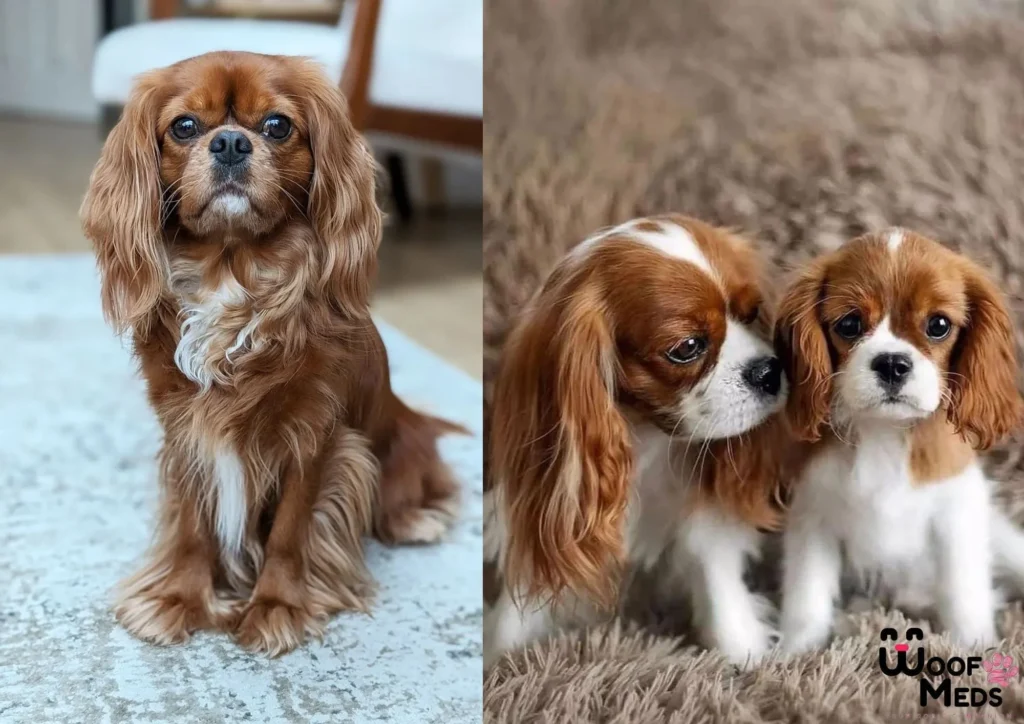“Loving, Loyal, and Elegant: Cavalier King Charles Spaniel”
The Cavalier King Charles Spaniel is a small, affectionate, and elegant toy breed that has captured the hearts of dog lovers for centuries. With its expressive eyes, silky coat, and charming personality, this breed is often considered the epitome of a perfect companion dog. Named after King Charles II of England, who was known for his love of these small spaniels, the Cavalier King Charles Spaniel has a rich history and continues to be a popular choice for families and individuals alike.
In this comprehensive guide, we will explore the history, characteristics, temperament, care, and health concerns of the Cavalier King Charles Spaniel. Whether you are considering adding one to your family or are simply interested in learning more about this delightful breed, this article will provide you with everything you need to know.
History of the Cavalier King Charles Spaniel
The history of the Cavalier King Charles Spaniel dates back to the 16th century when small toy spaniels were favored by European royalty and nobility. These dogs were often depicted in paintings alongside their aristocratic owners, symbolizing wealth and status. King Charles I and King Charles II of England were particularly fond of these spaniels, and the breed eventually took on the name “King Charles Spaniel” in their honor.
King Charles II was especially enamored with these dogs, to the point where they were allowed unrestricted access to the royal court and even parliament. His devotion to the breed contributed to its popularity, and these small spaniels became a common sight in the homes of the English nobility.
However, during the 19th century, the breed’s appearance began to change as it was crossed with other small breeds, such as the Pug and Japanese Chin. This led to the development of the modern English Toy Spaniel, also known as the King Charles Spaniel, which had a shorter nose and a more domed head.
In the early 20th century, efforts were made to revive the original appearance of the breed as depicted in older portraits. An American named Roswell Eldridge offered prize money at the Crufts Dog Show in 1926 to encourage breeders to recreate the “old-type” spaniel with a longer muzzle and flatter skull. This renewed interest led to the development of the Cavalier King Charles Spaniel, which was officially recognized as a distinct breed by the Kennel Club in the UK in 1945.
Here’s a table summarizing the breed characteristics of the Cavalier King Charles Spaniel:
| Characteristic | Description |
|---|---|
| Size | Small (12-13 inches tall, 13-18 pounds) |
| Coat | Silky, medium-length, can be slightly wavy or straight |
| Colors | Blenheim, Tricolor, Ruby, Black and Tan |
| Temperament | Affectionate, friendly, social, loyal, gentle |
| Energy Level | Moderate, enjoys playtime and regular walks |
| Trainability | Intelligent, eager to please, responds well to positive reinforcement |
| Social Compatibility | Good with children, other pets, and strangers |
| Grooming Needs | Regular brushing (3+ times per week), moderate shedding |
| Common Health Issues | Mitral Valve Disease, Syringomyelia, Hip Dysplasia, Eye Conditions |
| Life Expectancy | 12-15 years |
| Ideal Living Environment | Adaptable to apartments or houses, needs companionship |
| Exercise Requirements | Daily walks and playtime |



Physical Characteristics
The Cavalier King Charles Spaniel is a small, graceful dog with a well-balanced and elegant appearance. They typically weigh between 13 to 18 pounds (5.9 to 8.2 kg) and stand about 12 to 13 inches (30 to 33 cm) tall at the shoulder. Despite their small size, they are sturdy and well-proportioned.
Coat and Colors
One of the most striking features of the Cavalier King Charles Spaniel is its silky, medium-length coat, which can be slightly wavy or straight. The breed comes in four recognized color patterns:
- Blenheim: Chestnut markings on a white background, often with a distinctive chestnut “thumbprint” spot on the forehead.
- Tricolor: Black and white with tan markings on the eyebrows, cheeks, inside the ears, and under the tail.
- Ruby: A rich, solid red color all over the body.
- Black and Tan: Black with tan markings similar to those of the Tricolor.
The coat requires regular grooming to prevent matting and to maintain its luxurious appearance. Cavaliers are moderate shedders, and brushing them a few times a week will help keep loose hair under control.
Facial Expression
The Cavalier King Charles Spaniel is known for its sweet and gentle expression, which is enhanced by its large, dark, round eyes. The eyes are set wide apart and give the breed its characteristic soft and endearing look. The ears are long and set high on the head, with a slight wave in the hair that adds to the breed’s elegant appearance.
Temperament and Personality
The Cavalier King Charles Spaniel is renowned for its affectionate and friendly nature. They are often described as “lap dogs” due to their love of cuddling and close contact with their owners. Cavaliers are happiest when they are with their human family members and are known to form strong bonds with them.
Affectionate and Social
Cavaliers are incredibly social dogs that thrive on companionship. They are known for being friendly with everyone they meet, including children, other dogs, and even strangers. This breed is not known for being aggressive or overly shy, making them an ideal choice for families with children or other pets.
Playful and Energetic
While Cavaliers are often content to relax on the couch with their owners, they also have a playful side. They enjoy playing fetch, going for walks, and engaging in other activities that allow them to burn off energy. Despite their small size, they have a surprising amount of stamina and can keep up with more active families.
Intelligent and Trainable
Cavaliers are intelligent dogs that are eager to please, which makes them relatively easy to train. They respond well to positive reinforcement methods, such as treats and praise, and they enjoy learning new tricks and commands. However, they can be sensitive to harsh training methods, so it’s important to use gentle and consistent techniques.
Loyal and Loving
Above all, Cavaliers are loyal and loving companions. They are known for their ability to sense their owner’s mood and will often stay close by to offer comfort and affection. This breed is often described as a “velcro dog” because they love to stick close to their owners. Their loyalty and devotion make them an excellent choice for those seeking a constant companion.
Care and Maintenance
Owning a Cavalier King Charles Spaniel requires a commitment to their care and maintenance to ensure they remain healthy and happy. From grooming to exercise, here are some key aspects of caring for a Cavalier.
Grooming
The Cavalier’s silky coat requires regular grooming to prevent tangles and matting. Brushing them at least three times a week is recommended to keep their coat in good condition. Pay special attention to the ears, as the long hair can become tangled and may require more frequent brushing.
Regular bathing is also important to keep the coat clean and free from dirt and debris. Use a mild dog shampoo to avoid stripping the coat of its natural oils. Be sure to dry the coat thoroughly after bathing to prevent any lingering dampness, which can lead to skin issues.
In addition to coat care, regular ear cleaning is essential for this breed. The Cavalier’s long ears can trap moisture and dirt, making them prone to ear infections. Use a veterinarian-recommended ear cleaner to gently clean the ears and check them regularly for signs of redness, odor, or discharge.
Teeth brushing is another important aspect of Cavalier care. Like many small breeds, Cavaliers are prone to dental issues, so regular brushing with dog-specific toothpaste is recommended to prevent plaque buildup and gum disease.
Exercise
While Cavaliers are small dogs, they still require regular exercise to maintain their physical and mental health. A daily walk of about 30 minutes to an hour is usually sufficient, along with some playtime in a secure yard or indoor space. Cavaliers enjoy playing fetch, chasing after toys, and even participating in dog sports such as agility or obedience.
It’s important to monitor their activity level, especially in hot weather, as they can be prone to overheating. Always provide fresh water and shade during outdoor activities, and avoid strenuous exercise during the hottest parts of the day.
Diet and Nutrition
Feeding a Cavalier King Charles Spaniel a balanced and nutritious diet is crucial for their overall health. High-quality commercial dog food that meets their specific needs based on age, size, and activity level is recommended. It’s important to measure their food portions to prevent overfeeding, as Cavaliers can be prone to obesity.
Treats should be given in moderation and should not exceed 10% of their daily caloric intake. Healthy treats such as small pieces of fruits, vegetables, or specially formulated dog treats are good options.
Always provide fresh, clean water, and ensure that your Cavalier has access to it at all times.
Health Concerns
Like all breeds, the Cavalier King Charles Spaniel is prone to certain health issues. Responsible breeding practices can help reduce the risk of genetic conditions, but potential owners should be aware of common health concerns associated with this breed.
Mitral Valve Disease (MVD)
Mitral Valve Disease is one of the most common and serious health concerns in Cavaliers. This condition affects the heart’s mitral valve, leading to heart murmurs and eventually heart failure. MVD is a progressive disease, and regular veterinary check-ups are essential to monitor the heart’s health.
Early detection through routine examinations and echocardiograms can help manage the condition and improve the quality of life for affected dogs. There is no cure for MVD, but medications and lifestyle changes can help slow the progression of the disease.
Syringomyelia (SM)
Syringomyelia is a neurological condition that occurs when fluid-filled cavities, known as syrinxes, develop within the spinal cord. This condition is often associated with a malformation of the skull, which can cause pressure on the brain and spinal cord. Symptoms of SM include pain, sensitivity to touch, and difficulty walking.
While SM can be a debilitating condition, early diagnosis and treatment can help manage the symptoms. Treatment options may include medications to reduce pain and inflammation, and in severe cases, surgery may be recommended.
Hip Dysplasia
Hip dysplasia is a genetic condition that affects the hip joint, leading to pain and mobility issues. While more commonly associated with larger breeds, Cavaliers can also be affected by this condition. Regular veterinary check-ups and maintaining a healthy weight can help manage hip dysplasia and improve the dog’s quality of life.
Eye Conditions
Cavaliers are prone to several eye conditions, including cataracts, progressive retinal atrophy (PRA), and dry eye. Regular eye examinations by a veterinarian are important to detect and treat these conditions early. Some eye conditions may require surgical intervention, while others can be managed with medication.
Patellar Luxation
Patellar luxation is a condition where the kneecap dislocates or moves out of its normal position. This can cause pain and difficulty walking. In mild cases, the kneecap may return to its normal position on its own, but severe cases may require surgical correction.
Episodic Falling Syndrome
Episodic Falling Syndrome is a neurological disorder that affects muscle coordination, leading to episodes of muscle stiffness or collapse. This condition is specific to Cavaliers and can vary in severity. While there is no cure for this syndrome, management through medication and avoiding triggers can help reduce the frequency and severity of episodes.
Living with a Cavalier King Charles Spaniel
The Cavalier King Charles Spaniel is an adaptable breed that can thrive in various living environments, from apartments to large homes. Their small size makes them well-suited to urban living, but they are equally happy in the countryside, provided they get enough exercise and mental stimulation.
Family Life
Cavaliers are known for their gentle and patient nature, making them excellent companions for families with children. They are tolerant of children’s antics and enjoy being involved in family activities. However, it’s important to teach children how to interact with dogs respectfully to prevent accidental injuries.
Cavaliers also get along well with other pets, including dogs and cats. Their friendly and non-aggressive nature makes them a good choice for multi-pet households. However, their natural hunting instinct may lead them to chase smaller animals, so supervision is recommended.
Alone Time
Cavaliers are highly social dogs that do not enjoy being left alone for long periods. They thrive on companionship and can develop separation anxiety if left alone for extended periods. This breed is best suited for families where someone is home most of the time or where they can be accompanied by another dog for company.
Travel and Adventures
Cavaliers are generally good travelers and enjoy accompanying their owners on adventures. Whether it’s a trip to the park, a weekend getaway, or a longer vacation, Cavaliers are usually happy to be included. Their small size makes them easy to transport, and they are typically well-behaved in new environments.
Conclusion
The Cavalier King Charles Spaniel is a delightful breed that offers the perfect blend of affection, elegance, and companionship. Their loving nature, combined with their beautiful appearance and adaptability, makes them an ideal choice for a wide range of households. Whether you are looking for a loyal family pet, a playful companion, or a gentle lap dog, the Cavalier King Charles Spaniel is sure to steal your heart.
Owning a Cavalier requires a commitment to their care, including regular grooming, exercise, and health monitoring. While they are prone to certain health issues, responsible breeding and regular veterinary care can help ensure that your Cavalier enjoys a long, happy, and healthy life.
If you are considering adding a Cavalier King Charles Spaniel to your family, be prepared to welcome a loving and devoted companion into your life. This breed’s unwavering loyalty and affectionate nature will bring joy and warmth to your home for years to come.
FAQ
1. What is the origin of the Cavalier King Charles Spaniel?
The Cavalier King Charles Spaniel originated in England and is named after King Charles II, who was known for his love of small spaniels. The breed was developed in the 16th century and became popular among European royalty and nobility.
2. What are the common coat colors of the Cavalier King Charles Spaniel?
The breed comes in four recognized color patterns:
- Blenheim: Chestnut markings on a white background.
- Tricolor: Black and white with tan markings.
- Ruby: Solid rich red.
- Black and Tan: Black with tan markings.
3. What is the typical temperament of a Cavalier King Charles Spaniel?
Cavaliers are affectionate, friendly, and social dogs. They are known for their gentle nature, loyalty, and love of human companionship. They get along well with children, other pets, and strangers.
4. How much exercise does a Cavalier King Charles Spaniel need?
Cavaliers have moderate energy levels and require daily exercise. A 30-minute walk, along with some playtime, is usually sufficient. They enjoy activities like fetch and can also participate in dog sports like agility.
5. Are Cavalier King Charles Spaniels easy to train?
Yes, Cavaliers are intelligent and eager to please, making them relatively easy to train. They respond well to positive reinforcement methods such as treats and praise. However, they can be sensitive to harsh training techniques.
6. What grooming is required for a Cavalier King Charles Spaniel?
Cavaliers require regular grooming to maintain their silky coat. Brushing at least three times a week is recommended to prevent tangles and matting. Regular ear cleaning, teeth brushing, and occasional baths are also important.
7. What are common health issues in Cavalier King Charles Spaniels?
Cavaliers are prone to several health conditions, including Mitral Valve Disease (MVD), Syringomyelia (SM), hip dysplasia, eye conditions, and patellar luxation. Regular veterinary check-ups are essential for early detection and management of these issues.
8. Do Cavalier King Charles Spaniels get along with other pets?
Yes, Cavaliers generally get along well with other dogs and pets, including cats. Their friendly and non-aggressive nature makes them a good fit for multi-pet households.
9. How long do Cavalier King Charles Spaniels typically live?
The average life expectancy of a Cavalier King Charles Spaniel is 12 to 15 years. Providing them with a healthy diet, regular exercise, and routine veterinary care can help ensure a long and happy life.
10. Are Cavalier King Charles Spaniels good for apartment living?
Yes, Cavaliers are well-suited to apartment living due to their small size and adaptable nature. However, they still need daily exercise and mental stimulation to prevent boredom and maintain their overall health.
11. Can Cavalier King Charles Spaniels be left alone for long periods?
Cavaliers are highly social dogs and do not do well when left alone for extended periods. They can develop separation anxiety if left alone frequently, so they are best suited to homes where someone is usually present or where they have the company of another pet.
12. What is the best diet for a Cavalier King Charles Spaniel?
A high-quality commercial dog food that meets the breed’s specific needs based on age, size, and activity level is recommended. It’s important to monitor their food intake to prevent obesity, as Cavaliers can be prone to weight gain.



